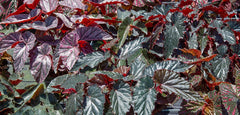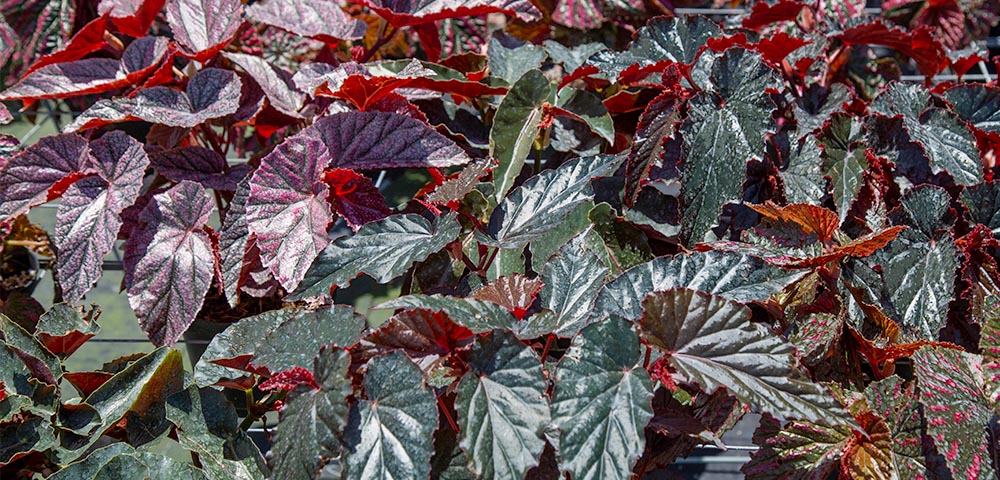Cane Begonia (Begonia spp.)
Cane Begonia Plant Features
Add a big burst of color and texture to your home, office, or other indoor space with Cane begonias! Cane begonias are also sometimes called angel wing begonias. There are dozens of varieties, many of which feature vividly variegated foliage.Cane begonias earned their common name because they have sturdy, upright stems (which are often compared to bamboo). Different varieties grow to various sizes. You can find selections that range from a couple of feet to more than 5 feet tall in good growing conditions. The angel wing moniker came about because many varieties have long leaves that you can say are wing-like in shape.
Regardless of the name, these begonia varieties show off foliage in shades of green, purple, pink, silver, and other colors. Many varieties are variegated with other shades. In fact, Polka Dot Begonia (Begonia maculata) is considered a type of cane begonia.
Their flamboyant foliage make cane begonias ideal to display by themselves or as a part of a bigger plant collection. Young plants are beautiful addition to bright desks and tabletops. As they mature, cane begonias are outstanding floor plants if you let them get tall. (Note: Most benefit from staking as they age.) Their lovely leaves aren’t their only point of eye appeal. Most produce clusters of pink or white flowers when happy.
Cane Begonia Growing Instructions
Cane Begonia Light NeedsBe sure to grow cane begonias in a spot with lots of light. Ideally, the plant should cast a medium to strong shadow most of the day. That's at least 300 foot candles if you measure that way. If it does not receive enough light, a cane begonia typically grows lanky and spindly, often having weak, brittle stems. In Northern areas, cane begonias may tolerate some direct sun through a window, especially in the winter months. In the South, watch for sunburn if the plants are exposed to a lot of direct afternoon sunlight.
Cane Begonia Water Needs
Water your cane begonias as the top few inches of the potting mix start to dry out. These beautiful houseplants are susceptible to root rot if they get too much water. This is particularly prevalent in low-light spots. If a cane begonia gets too dry, it often develops brown, crispy leaf tips or edges. It may drop its new leaves before they fully mature.
Cane Begonia Humidity Needs
Most cane begonias enjoy average to above-average relative humidity levels. If the air in your home or office is dry, try grouping cane begonias together with other indoor plants to try to create humidity zones. You can also place a small humidifier nearby to add moisture to the air.
Cane Begonia Fertilizer Needs
Not sure if/when you need to fertilize cane begonias? You’re not alone! If you wish to, fertilize these houseplants in spring and summer with a general-purpose houseplant fertilizer. Cane begonias aren’t fussy as to type. Follow the instructions on the product packaging for application rate and frequency. You can always scale back on fertilizer, but never use more than the package recommends.
Pruning Cane Begonias
Pruning may necessary, depending on variety, if you want to keep your plant small and compact. If you don’t mind your cane begonia getting tall and majestic, particularly if you have bright light, it may not need pruning. To prune it, just pinch off the top couple of inches of new growth for bushiness and to get the plant to branch out more. This creates a fuller-looking plant. (Tip: You can pot up the tips you pinch off in moist sand, perlite, or vermiculite and grow them out as cuttings to propagate your plant.)
-
Water
Medium water needs
-
Light
Indoors: High light
-
Colors
Green
Pink
Purple
Red
Silver
Variegated
-
Special Features
Colorful foliage
Purifies the air
Complement your Cane Begonia
Colorful AglaonemaCan't get enough color in your houseplant collection? Mix cane begonias with variegated Colorful Aglaonema!
Moonlight Scindapsus
Accent the silvery variegation found on many cane begonias with the cool, almost metallic leaves of Scindapsus 'Moonlight'.
Little Fiddle Fig
Contrast cane begonia's fabulous variegated foliage with the textural leaves of Little Fiddle Fig.

